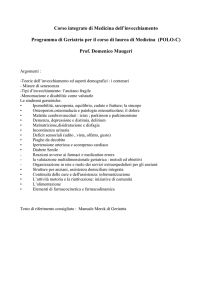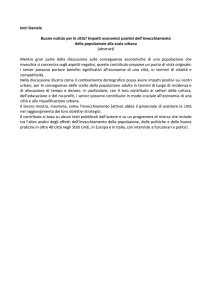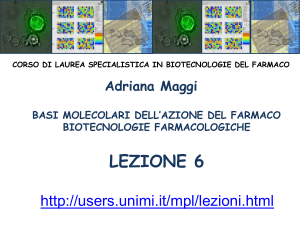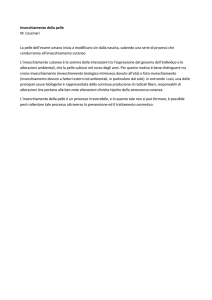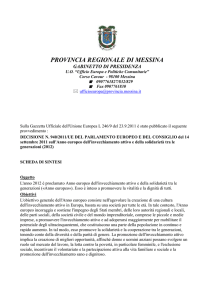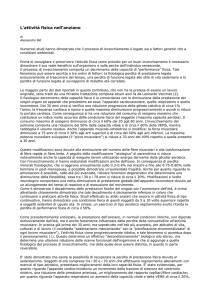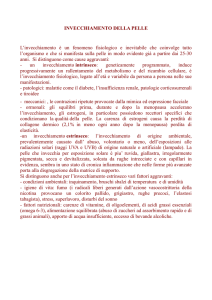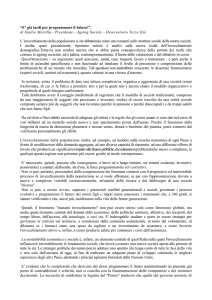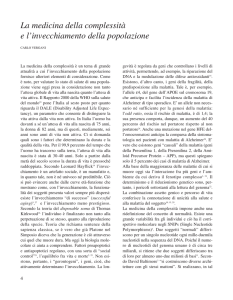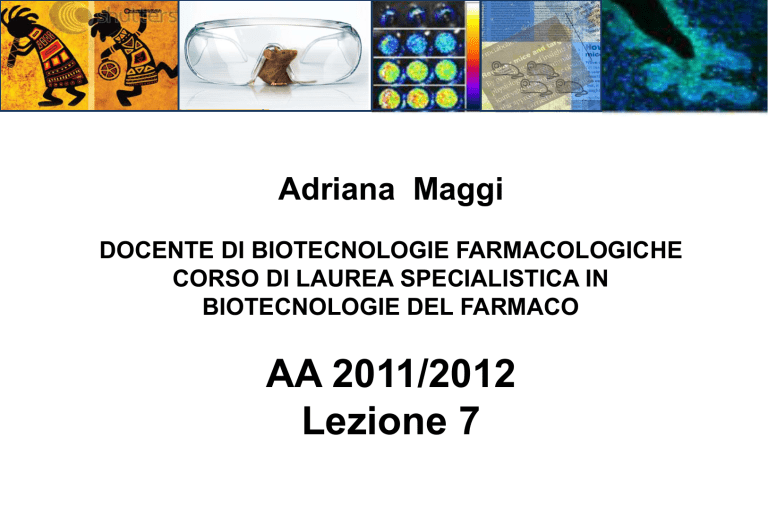
Adriana Maggi
DOCENTE DI BIOTECNOLOGIE FARMACOLOGICHE
CORSO DI LAUREA SPECIALISTICA IN
BIOTECNOLOGIE DEL FARMACO
AA 2011/2012
Lezione 7
LE BASI BIOLOGICHE DELL’ INVECCHIAMENTO
Invecchiamento
e genetica
Invecchiamento
e ambiente
Regolazione endocrina
dell’invecchiamento
Non-Programmed Passive Aging Theories
• Aging is a passive result of an organism’s inability to better resist
fundamental deteriorative processes.
• Aging serves no purpose, is not an adaptation, is not programmed.
• Compatible with traditional evolutionary mechanics theory. Mammals
needing more time for development needed a longer life span and
therefore developed better maintenance and repair mechanisms that
consequently delayed onset of age-related symptoms and diseases
relative to shorter-lived mammals.
• Poor fit to many other observations of humans, other mammals, and
other organisms particularly those that die suddenly from apparent
biological suicide following reproduction rather than from gradual
deterioration (e.g. Octopus, salmon)
Programmed Active Aging Theories
• Organisms are purposely designed and genetically programmed to age or
otherwise limit life span because the deterioration and life span
limitation serves an evolutionary purpose.
• Aging is an adaptation, a purposeful design feature resulting from the
evolution process.
• Aging is the result of a potentially complex active aging mechanism or
“life span management system.”
• The mechanism could sense external conditions in order to adapt life
span to local or temporary conditions and could operate by manipulating
the maintenance and repair functions.
Aging Theory Status
• “Main line” consensus of current gerontologists favors the
passive theories. Earlier simple deterioration theories have
little current scientific credibility in the biology community
while still popular in the human-oriented (physician)
community.
• Some relatively recent discoveries appear to favor aging-bydesign theories.
• Efforts to explain aging based on traditional mechanics and
efforts to explain other discrepancies with alternative
mechanics cannot be simultaneously valid. Eventually there
will be a unified theory.
“Non-Aging” Species
• Some species have been identified that apparently do not age or have
negligible senescence. Older individuals do not appear to be weaker, less agile,
less reproductive, more susceptible to disease, or otherwise less fit than
younger animals. (Ages of some wild animals can be determined by annual
marks in scales or bones similar to tree rings.)
• Some species with age of oldest recorded specimen:
Rougheye Rockfish 205 Years
Lake Sturgeon152 Years
Aldabra Tortise152 Years
• Common U.S. Eastern Box Turtle is also long-lived (~100 years).
• Non-aging species tend to defeat simple deterioration theories and
suggest dramatically longer human life spans are possible.
QUALE APPROCCIO SEGUIRE PER LO STUDIO
DELLE BASI MOLCOLARI DELL’INVECCHIAMENTO?
Aging Theories
Planned Obsolescence Theory
Telomerase Theory of Aging
The Neuroendocrine Theory
The Free Radical Theory
Mitochondrial Theory of Aging
The Membrane Theory of Aging
The Hayflick Limit Theory (The cell waste accumulation)
Glycosylation Theory of Aging
Immune system alterations
MALATTIE GENETICHE
ESEMPI DI INVECCHIAMENTO PRECOCE
Progeria and Werner Syndrome
• Hutchinson-Guilford Progeria, a very rare human genetic disease,
accelerates many symptoms of aging including atherosclerotic heart
disease. Victims usually die by age 13.
• Werner syndrome, another genetic disease, involves acceleration of
most symptoms of aging including baldness, hair and skin conditions,
heart disease, calcification of blood vessels, some cancers, cataracts,
arthritis, diabetes, etc. Victims usually die by age 50.
• These conditions suggest aging is centrally controlled such that a
single genetic defect could result in proportionally accelerating all of
the expressed symptoms. Central control suggests aging-by-design
Il gene LMNA che codifica per le laminine di
tipo A è stato caratterizzato nel 1993 e
mappato sul cromosoma 1q21.2-q21.3 (Lin and
Worman 1993; Wydner et al. 1996).
La prima malattia umana causata da mutazioni
della laminina A identificata per mezzo di
clonaggio posizionale era autosomica
dominante e determinava la distrofia
muscolare Emery-Dreifuss
Laminopatie
• Autosomal dominant (and
rarely recessive) EmeryDreifuss muscular dystrophy
• Cardiomyopathy dilated 1A
• Limb-girdle muscular dystrophy
type 1B
• Congenital muscular dystrophy
• “Heart-hand” syndrome
• Adipose Tissue
• Dunnigan-type familial partial
lipodystrophy
• Lipoatrophy with diabetes and
other features of
• insulin resistance
• Atypical lipodystrophy
syndromes
• Mandibuloacral dysplasia
• Peripheral Nerve
• Charcot-Marie-Tooth disease
type 2B1
• Progeria Phenotype
• Hutchinson-Gilford progeria
syndrome
• Atypical Werner Syndrome
• Variant progeroid disorders
• Mandibuloacral Dysplasi
Funzioni delle laminine
Capell and Collins Nature Reviews Genetics 7, 940–952 (December 2006) | doi:10.1038/nrg1906
CharcotMarie-Tooth
Lipodistrofia
familiare
Displasia mandibulo
sacrale
progeria
Hutchinson-Gilford progeria syndrome
Una malattia autosomica dominante e sporadica e rara che
determina invecchiamento precoce: in genere il paziente muore a
13 anni circa per patologie cardiache
La base genetica per molti casi di questa patologia consiste
nella mutazione della tripletta GGC
della laminina A (LMNA) .
in GGT nel codone 608
Questo determina l’insorgenza di un sito di splicing criptico porta
alla sintesi di una proteina con una delezione di 50 aa. La regione
deleta ha in se la sequenza riconosciuta da enzimi proteolitici che
fanno maturare la Laminina. In mancanza di questa parte della
proteina, questa viene carbossifarnesilata e si accumula a livello
endocellulare e soprattutto a causa della farnesilazione, nella
membrana nucleare.
Invecchiamento e genetica
Figure 1. Processing of lamin A in normal and HGPS cells
Meshorer E., Gruenbaum Y. J. Cell Biol. 2008:181:9-13
La presenza di laminina mutata (progerin)altera le
funzione della membrana nucleare, la sua
permeabilità e la trascrizione genica
.
The is a mouse model of progeria where the
prelamin A is not mutated. Instead, the
metallopeptidase ZMPSTE24, the specific
protease that is required to remove the C-terminus
of prelamin A, is missing.
INVECCHIAMENTO E PROGERIE
I malati di progerie non mostrano:
deficit cognitivi
elevati livelli ematici di colesterolo e LDL
elevati livelli di prot C reattiva
Che generalmente si accompagnano all’invecchiamento
SINDROME DI WERNER
I portatori di mutazioni che dterminano la sindrome
di Werner manifestano molto precocemente:
cataratta, arteriosclerosi, osteoporosi, diabete mellito
di tipo II, tumori di origine mesenchimale.
Generalmente la causa di morte è infarto o tumori.
Sindrome di Werner
Una patologia autosomica recessiva
La mutazione genica è a carico
della DNA elicasi (cromosoma 8
braccio corto) che accorcia la
lunghezza dei telomeri.
La malattia si manifesta alla
pubertà e i portatori della
mutazione vivono fino circa 40
anni di età.
A. Topo I usually found in eukaryotes
binds the 3’ end of the broken DNA
strand, and removes (+) or (-)
supercoils. As replicating DNA moves
through the structure, the two parental
strands (black) are separated by the
helicase, while positive supercoiling is
removed by the 3’ topoisomerase.
B. A machine able to separate the
daughter
molecules at the end of replication is
formed by a helicase (red) removing the
last turns of parental DNA and a type II
topoisomerase
(green) untangling the daughter
duplexes.
C. Nucleosome disruption.
The positive supercoiling produced by
the translocating helicase H (red)
destabilizes the nucleosome, while a
topoisomerase T (5’ or 3’ Topo I,
or eukaryotic topo II, green) efficiently
relaxes the negative supercoiling,
reforming the normal duplex behind
the helicase.
MAPPA DELLE MUTAZIONI
IN PAZIENTI CON MALATTIA DI WERNER
HRDC: Human Hematopoietic Cell Derived Rna Cyclase
Le proteine che interagiscono direttamente
con la RecQ elicasi comprendono:
Ku70/80, BLM, FEN1, TRF2, p53, polß, polδ,
RAD51, RAD52, RAD54B, RPA, POT1, PCNA,
PARP1, MRE11, e Cdc5L
coinvolte in:
Replicazione del DNA,
Riparazione del DNA,
Ricombinazione
Metabolismo dei telomeri
Telomero = una regione di DNA ripetitivo al termine
del cromosoma necessario per proteggere la parte
terminale del cromosoma stesso nei confronti di
enzimi degradativi o fusioni con cromosomi vicini.
telos (τέλος) “fine“
merοs (μέρος, root: μερ-) "parte".
Con la replicazione dei cromosomi il terminale dei
cromosomi si erode e la parte del telomero si
accorcia. Un telomero in una cella giovane puo’
raggiungere le 15000 paia di basi (ogni divisione si
raccorcia di 25-200 pb)
double stranded, a G-rich single strand
forms a terminal 3' overhang
Telomeric repeat-binding factor 1
Telomerase is a
ribonucleoprotein polymerase
that maintains telmere ends by
addition of the telomere repeat
TTAGGG
INVECCHIAMENTO
E SINDROME DI WERNER
REGOLAZIONE ENDOCRINA
DELL’INVECCHIAMENTO
Drosophila melanogaster
STUDIARE VERMI E
INSETTI
PER CAPIRE L’UOMO
Coenorabditis elegans
CICLO VITALE DI C.ELEGANS
adulto
L4
Circa 3 giorni a
22°C
L3
embrioni
L1
L2
CICLO VITALE DI C.ELEGANS
adulto
embrioni
L4
MANCANZA DI
ALIMENTI
STADIO DAUER
L1
LARVA
LARVA DAUER
Studio di processi biologici legati
a una maggiore morbidità
l’esempio dell’invecchiamento
DAF 7 ( TGFb ligand)
DAF1 (IGF-R)
DAF 4 (Type II TGFbR)
AGE 1 (IP3-K)
DAF 3, DAF 5 (SMAD prot)
DAF 16*
DAF 12
3-keto-cholestenoic acid metabolite
DAUER
SIR2 (deacetilasi attiva di DAF 16)
DAF9 (cytochrome C
CYP27A1)
* Proteine della famiglia FOXO coinvolte nel metab del glucosio
GH
Insulin/IGF-1
Insulin/IGF-1
DAF 2 receptor
IGF-1R
dFOXO
DAF 16/FOXO (adip. Tissue)
TOR
LONGEVITY
germline
IGF-1
1R
TOR
LONGEVITY
germline
Insulin
LONGEVITY
Invecchiamento e ambiente
EVOLUTION:
LAND OF BIOLOGICAL EQUAL OPPORTUNITIES
“EFFECTOR”
SEXUAL REPRODUCTION
“REGULATORS”
NUTRIMENT
AGE
EVOLUTION:
LAND OF BIOLOGICAL
EQUAL OPPORTUNITIES
DEATH: A TOOL INDISPENSABLE
TO ENSURE THE CONTINUATION
OF THE SPECIE
• FECUNDITY SHOULD BE
DIRECTLY PROPORTIONAL
TO NUTRIENT AVAILABILITY,
but
• HIGH NUTRIENT AVAILABILITY,
FAVORING FECUNDITY, SHOULD
SHORTEN THE LIFE SPAN
SEXUAL REPRODUCTION
AGING
AS NECESSITY FOR THE CONTINUATION OF LIFE
and
AS A MEAN TO GIVE TO EACH INDIVIDUAL EQUAL
POSSIBILITIES TO GIVE HIS GENETIC CONTRIBUTION TO THE
NEXT GENERATION
Intrinsic program for aging aiming at increasing the
fraility of the organism:
a biological clock(telomers length, mitochondrial
viability; DNA replication errors, loss of immune
control and inflammation…)
sex-dependent (male fecundity cannot be limited as
well as in females)
Extrinsic factors
Fertility-driven
nutrition
adaptable environment

